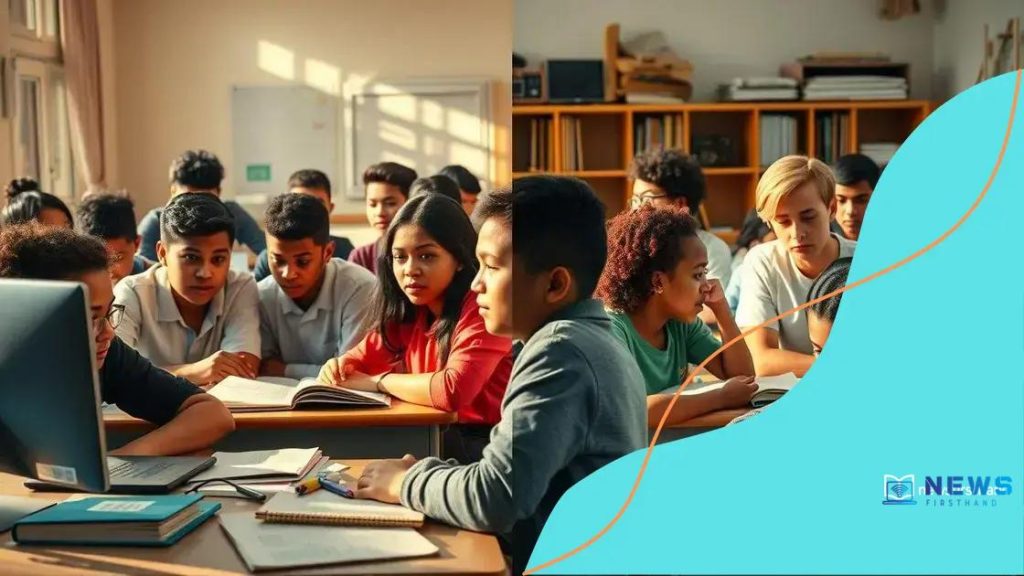Education inequality: understanding its impact on society

Education inequality arises from unequal access to educational resources and opportunities, significantly impacting students’ academic success based on socioeconomic status and location.
Education inequality remains a pressing issue, shaping futures and life chances for many. What causes this divide, and how can we work together to bridge it? In this article, we’ll delve into its causes, effects, and potential solutions.
Defining education inequality
Education inequality is a significant barrier to achieving a fair and just society. It refers to the unequal distribution of resources and opportunities in the education system. This disparity affects students from different backgrounds, limiting their potential and future success.
Understanding the key aspects of education inequality is crucial. One of the main factors is socioeconomic status. Families with limited financial means often struggle to provide the necessary resources for their children’s education. This can lead to less access to quality schools, experienced teachers, and essential learning materials.
Key Factors Contributing to Education Inequality
Several factors contribute to education inequality:
- Funding disparities: Schools in wealthier areas receive more funding, leading to better facilities and programs.
- Geographical location: Students in rural or underserved urban areas may have limited access to quality education options.
- Discrimination: Some students face biases based on race, gender, or disability, affecting their educational opportunities.
These elements create a cycle of disadvantage that is hard to break. Students in underfunded schools often do not achieve their full potential, perpetuating the cycle of education inequality. Addressing these issues requires a collective effort from policymakers, educators, and communities.
Furthermore, parental involvement plays a crucial role in a child’s educational success. Parents who are engaged can help bridge some gaps, providing support and encouragement. However, families facing challenges may lack the resources or time to be fully involved in their child’s education.
The effects of education inequality on society
The impact of education inequality extends far beyond the classroom. It shapes society in numerous ways, affecting not just individual students but entire communities. When children do not receive a quality education, it creates a ripple effect that influences economic growth, social mobility, and public health.
One key effect is on the economy. Individuals who lack access to education often struggle to find good jobs. This leads to lower wages, which means less spending in the community. As a result, local economies suffer, leading to a cycle of poverty that can be hard to escape.
Social Consequences of Education Inequality
Education inequality can also worsen social tensions. Communities divided by educational resources tend to experience:
- Increased crime rates: A lack of education often correlates with higher crime, as individuals may turn to illegal activities for income.
- Lower civic engagement: People who are not educated may feel disconnected from society and less likely to participate in civic duties like voting.
- Widening social divides: Without equal educational opportunities, societal divisions based on class and race can become more pronounced.
The effects of education inequality create long-term challenges that can persist for generations. Students who do not receive a fair education are less likely to break the cycle of poverty. Furthermore, as these students become adults, their limited education affects their children, perpetuating a cycle of disadvantage.
Moreover, disparities in education can lead to health issues. Studies show that individuals with lower levels of education often have poorer health outcomes. This is linked to both limited access to healthcare and the inability to make informed health choices. Consequently, education inequality affects not only the economy but also the overall well-being of society.
Key statistics on education disparity

Understanding the scope of education disparity requires looking at key statistics. These figures illustrate the extent of the problem and highlight the urgent need for action. The statistics reveal how education inequality affects various groups and communities across different regions.
For instance, according to recent studies, over 50 million students attend public schools in the United States alone. However, substantial disparities exist based on income and location. Students in low-income areas are less likely to have access to qualified teachers and advanced coursework. This limits their ability to compete with peers from wealthier districts.
Significant Facts About Education Disparity
Here are some notable statistics that showcase education inequality:
- 25%: The percentage of students in high-poverty schools who drop out before graduation.
- 12 years: The average difference in educational attainment between the wealthiest and poorest households.
- 1 in 5: The ratio of children living in low-income families attending high-quality preschool programs.
These numbers highlight that education disparity is not just a statistic; it affects the lives of millions of children. Furthermore, research indicates that schools with high percentages of low-income students face challenges such as inadequate funding and fewer resources. This creates an uneven playing field that puts these students at a disadvantage.
Moreover, the impact extends beyond education. Data shows that areas with lower educational attainment often experience higher rates of unemployment and crime. Addressing these disparities is crucial for improving overall societal health and economic growth, reaffirming the need for continued advocacy and reform.
Strategies to address education inequality
Addressing education inequality requires a comprehensive approach involving various strategies. By implementing targeted actions, we can help create a more equitable education system for all students. One significant way to tackle this issue is through community engagement and support.
Community programs can provide resources and opportunities for students in underserved areas. This can include after-school tutoring, mentorship programs, and access to technology. When communities come together to support education, students benefit greatly, leading to improved academic outcomes.
Policy Changes and Funding
Policy reforms are essential in combating education inequality. Governments can take several actions:
- Equitable funding: Allocate resources based on student needs rather than property taxes, ensuring all schools have the necessary support.
- Improving teacher training: Invest in training programs that equip teachers to handle diverse classrooms effectively.
- Expanding early childhood education: Increase access to quality preschool programs, which are crucial for developing foundational skills.
Moreover, involving parents and guardians is critical. Schools should encourage parental involvement through workshops and regular communication. This connection can foster a better home environment for learning, which can significantly impact student success.
Furthermore, leveraging technology in classrooms can also address some disparities. Providing students with the necessary devices and internet access can help bridge the gap. Access to online resources and learning platforms can enhance educational experiences for all students, regardless of their background.
Finally, collaboration between schools, local governments, and non-profits can create sustainable solutions. By working together, these entities can share resources and best practices, leading to a stronger educational system.
Success stories in overcoming education barriers
Success stories in overcoming education barriers provide hope and inspiration for many. These narratives highlight the resilience of students, educators, and communities that work together to create positive changes. They show that with determination and the right support, significant obstacles can be overcome.
One extraordinary example comes from a rural school district in the Midwest. Through community partnerships, they implemented a mentoring program that paired high school students with younger peers. This initiative not only boosted academic achievement but also fostered a sense of belonging. The results were impressive: graduation rates increased by over 20% within three years.
Innovative Programs That Made a Difference
Several innovative programs have proven effective in addressing education disparities:
- After-school tutoring: In low-income communities, after-school tutoring has helped students who struggle with core subjects like math and reading.
- Scholarship initiatives: Scholarships targeting underrepresented groups have opened doors for many students, allowing them to attend colleges they once thought were out of reach.
- Community workshops: Various organizations offer workshops that educate parents on how to support their children’s education, further enhancing student performance.
In urban areas, a notable program focused on providing resources for students in underfunded schools. By distributing laptops and internet access, students could complete assignments and conduct research more effectively. This access narrowed the tech gap, giving all students a fairer chance to succeed.
Furthermore, many success stories revolve around advocacy. Students, parents, and teachers organizing to demand better resources from local governments can result in positive changes in policy. Their voices remind us that collective action can lead to impactful reform in education.
In conclusion, addressing education inequality is vital for building a fair society. The stories of success remind us that with the right support, barriers can be overcome. Community involvement, innovative programs, and advocacy play crucial roles in this journey. By working together, we can ensure that all students have equal access to quality education and the opportunity to reach their full potential. Every small effort can contribute to significant change, making a lasting impact on future generations.
FAQ – Frequently Asked Questions about Education Inequality
What is education inequality?
Education inequality refers to the uneven distribution of resources and opportunities in the education system, affecting students based on their socioeconomic status, location, and other factors.
How can community support help address education inequality?
Community support, such as local mentoring programs and after-school tutoring, provides additional resources and encouragement for students, helping them succeed academically.
What role do policies play in reducing education disparity?
Effective policies aim to allocate resources equitably, ensure fair funding for schools, and create programs that increase access to quality education for all students.
How can individuals contribute to overcoming education barriers?
Individuals can advocate for policy changes, volunteer in local schools, support fundraising efforts, and share success stories to inspire others to take action.





